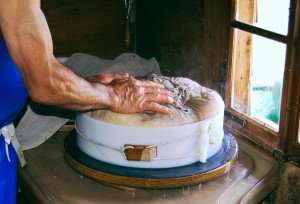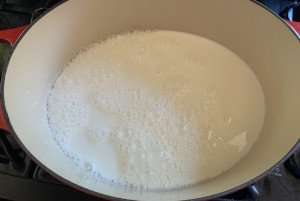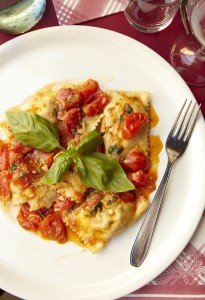Costa Rica's Favorite Meal: The Casado
February 7, 2025
Costa Rica is a fabulous destination for luxury travelers, as well as seniors, couples, and families, not least because of its many excellent dining options.…
Read This Post One of our culinary travelers’ favorite activities when they participate in our Italy cooking vacations is making cheese. This is not part of every itinerary: it depends on the region and the specific cooking vacation. But many of our culinary tours in Italy include cheese making, or at least a visit to see how cheese is produced.
One of our culinary travelers’ favorite activities when they participate in our Italy cooking vacations is making cheese. This is not part of every itinerary: it depends on the region and the specific cooking vacation. But many of our culinary tours in Italy include cheese making, or at least a visit to see how cheese is produced.
But did you know you can easily replicate the thrill of cheesemaking in your own home? Making homemade ricotta cheese is an easy and fun way to relive your cooking vacation in Italy!
 Cheese is, at its most basic, coagulated milk. There are different ways to cause the coagulation. Most cheeses use rennet to cause the coagulation, and rennet-coagulated cheese in general can be aged longer and kept longer.
Cheese is, at its most basic, coagulated milk. There are different ways to cause the coagulation. Most cheeses use rennet to cause the coagulation, and rennet-coagulated cheese in general can be aged longer and kept longer.
 An aside: what is rennet? Rennet is a set of enzymes used in making cheese. It is most often collected from the stomach of a young, unweaned animal (usually a calf). This makes vegetarian cheese almost an oxymoron. I say “almost” because there are plant-based rennets, although they are much less common. End of lesson!
An aside: what is rennet? Rennet is a set of enzymes used in making cheese. It is most often collected from the stomach of a young, unweaned animal (usually a calf). This makes vegetarian cheese almost an oxymoron. I say “almost” because there are plant-based rennets, although they are much less common. End of lesson!
 Ricotta cheese, however, does not use rennet for the coagulation. It uses some type of acid–usually lemon juice or vinegar–to curdle the milk. Then the curds are separated from the whey through straining, and voilà! You have cheese!
Ricotta cheese, however, does not use rennet for the coagulation. It uses some type of acid–usually lemon juice or vinegar–to curdle the milk. Then the curds are separated from the whey through straining, and voilà! You have cheese!
The production of ricotta in Italy uses whey left over from making other types of cheeses, mixed with a small amount of milk. This means that a large volume of liquid is required to make ricotta. The recipe here uses whole milk, as you are unlikely to have leftover whey at home from other cheese making! But it still requires a lot of milk. This recipe calls for one quart of milk and makes about one cup of ricotta. What is left over is a yellowy liquid called whey.
 There are a few different types of ricotta. I positively love ricotta romana, or ricotta di pecora, which is a sheep’s-milk ricotta. Ricotta salata is, as the name implies, salted, but it is also pressed and dried. You use it in such recipes as Sicilian pasta “alla norma,” if you can find it.
There are a few different types of ricotta. I positively love ricotta romana, or ricotta di pecora, which is a sheep’s-milk ricotta. Ricotta salata is, as the name implies, salted, but it is also pressed and dried. You use it in such recipes as Sicilian pasta “alla norma,” if you can find it.
In parts of Latin America there is a similar type of cheese called requesón. It has a slightly more fruity taste, but is extremely similar to ricotta. You will find it in Mexico and in Puerto Rico.
 A few tips:
A few tips:
 What do I use the ricotta for? There are a thousand uses. Some of my favorites are:
What do I use the ricotta for? There are a thousand uses. Some of my favorites are:
We hope you enjoy making your own homemade ricotta cheese. And remember, if you want to try your hand at cheese making in Italy, check out our Italy cooking vacations and culinary tours!

Prep time: 1 minute
Cook time: 5 minutes
Cook method: Boil
Serves: 2
 1. Line a large fine mesh sieve with cheese cloth. Place over a large heat-proof bowl and set aside.
1. Line a large fine mesh sieve with cheese cloth. Place over a large heat-proof bowl and set aside.
 2. Heat the milk in a large enamel or stainless steel pot. Bring just to a full boil, being careful not to let it boil over. Turn off the heat and add the lemon juice or vinegar. Give it one stir only, then allow the mixture to stand for a few minutes. Do NOT keep stirring it.
2. Heat the milk in a large enamel or stainless steel pot. Bring just to a full boil, being careful not to let it boil over. Turn off the heat and add the lemon juice or vinegar. Give it one stir only, then allow the mixture to stand for a few minutes. Do NOT keep stirring it.
 3. Pour the mixture into the sieve and let it strain for 20 to 30 minutes, removing the liquid from the bowl as needed to make sure it’s straining properly (save the liquid whey for other uses). The longer you let the ricotta strain, the more dense the ricotta will be.
3. Pour the mixture into the sieve and let it strain for 20 to 30 minutes, removing the liquid from the bowl as needed to make sure it’s straining properly (save the liquid whey for other uses). The longer you let the ricotta strain, the more dense the ricotta will be.
 4. Transfer the ricotta to a bowl and season with salt to taste. Cover and refrigerate, or use immediately.
4. Transfer the ricotta to a bowl and season with salt to taste. Cover and refrigerate, or use immediately.
By Peg Kern
Sign up to receive our newsletter, which includes travel tips, recipes, promotions, and information on our best cooking vacations.
Find more photos, videos, food facts, and travel stories from The International Kitchen on Facebook, Instagram, Pinterest, Twitter, and YouTube.